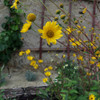Helianthus occidentalis - WESTERN SUNFLOWER
Western sunflower is one of the shortest perennial sunflowers and also the well behaving ones!
Grow only to 3-4' tall x 2' wide, it still spreads wide by rhizomes, but it is not as aggressive as many tall cousins. In years, it can form colonies, but you can easily reduce it's size.
Also it's structure is different - larger leaves stay at the base, forming kinda groundcovering layer of leaves, and thin reddish stalks, not much branched carry orange-yellow flowers. The whole plant looks ornamental and flowers for 1 month, starting July/August.
Full sun, preferably drained soils (sandy, rocky, shallow soils), medium-dry to dry. It will grow well in average garden soil, if you have clayish soil, amend it with some sand and little bit of compost.
This sunflower is also excellent pollinator plant - it attracts many species of native bees (long-tongued bees, short-tongued bees), miscellaneous flies, and occasional butterflies, and is a host plant for many small insects, grasshoppers, leafhoppers, but also for larvae of such butterflies as Gorgone Checkerspot, Silvery Checkerspot, Painted Lady) and several moths!
It's native to Central and eastern United States and hardy in zones 3 to 9. See the USDA distribution map.
Deer and rabbit resistant plant.
Highly recommended plant for home landscaping, sunny borders, cottage gardens, pollinator gardens, prairie planting, water wise and deer resistant plantings, cut flower garden or as an erosion control on dry or shallow soils.
For it's drought, heat and humidity tolerance is also recommended for urban landscaping and for it's elegant structure looks good with modern buildings too.
Pot Size : square 3.5" x 5" deep pot

Helianthus occidentalis - WESTERN SUNFLOWER
Western sunflower is one of the shortest perennial sunflowers and also the well behaving ones!
Grow only to 3-4' tall x 2' wide, it still spreads wide by rhizomes, but it is not as aggressive as many tall cousins. In years, it can form colonies, but you can easily reduce it's size.
Also it's structure is different - larger leaves stay at the base, forming kinda groundcovering layer of leaves, and thin reddish stalks, not much branched carry orange-yellow flowers. The whole plant looks ornamental and flowers for 1 month, starting July/August.
Full sun, preferably drained soils (sandy, rocky, shallow soils), medium-dry to dry. It will grow well in average garden soil, if you have clayish soil, amend it with some sand and little bit of compost.
This sunflower is also excellent pollinator plant - it attracts many species of native bees (long-tongued bees, short-tongued bees), miscellaneous flies, and occasional butterflies, and is a host plant for many small insects, grasshoppers, leafhoppers, but also for larvae of such butterflies as Gorgone Checkerspot, Silvery Checkerspot, Painted Lady) and several moths!
It's native to Central and eastern United States and hardy in zones 3 to 9. See the USDA distribution map.
Deer and rabbit resistant plant.
Highly recommended plant for home landscaping, sunny borders, cottage gardens, pollinator gardens, prairie planting, water wise and deer resistant plantings, cut flower garden or as an erosion control on dry or shallow soils.
For it's drought, heat and humidity tolerance is also recommended for urban landscaping and for it's elegant structure looks good with modern buildings too.
Pot Size : square 3.5" x 5" deep pot




